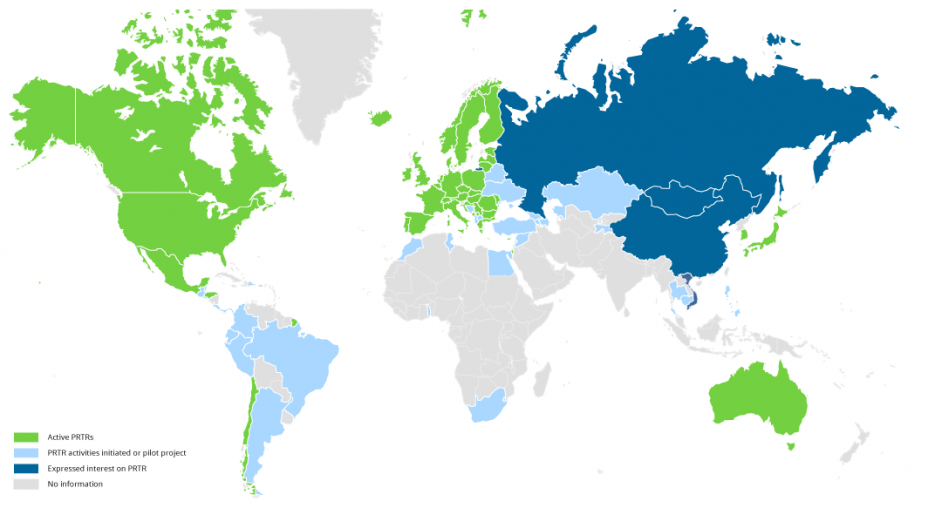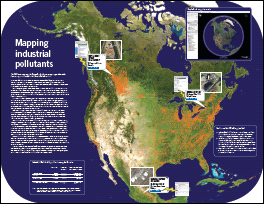TRI Around the World
The U.S. TRI Program: A Leader in International Chemical Release Reporting
Pollutant Release and Transfer Registers (PRTRs) are the data collection systems that track releases of pollutants into the environment and transfers of pollutants off site for waste disposal or other management. The Toxics Release Inventory (TRI) is the U.S. PRTR system. Established in 1987, TRI was the first system of this kind in the world. Since then, many countries have set up PRTRs following the TRI model. One of the primary purposes of these systems is to improve transparency regarding pollutant releases and transfers to better inform decision-making by the public, academics, policy makers, scientists, and representatives of industry.
Currently, at least 50 countries have fully established PRTRs or have implemented pilot programs, as shown in the map below. International PRTRs are similar to one another but vary in scope, taking into account individual country circumstances, such as existing regulations and the types of industry in the country. Many more PRTRs are expected to be developed in the coming years, particularly in Asian and South American countries.
 Source: United Nations Economic Commission for Europe
Source: United Nations Economic Commission for Europe
PRTR systems differ in their design and implementation, with variations in:
- Industry sectors covered
- Chemicals covered
- Reporting thresholds (chemical, sector, employment thresholds)
- Granularity of release data elements
- Years of data availability
These differences are important to consider when comparing data at a regional or global level. Granularity and data availability are particularly important as they tend to limit the comparability of data across PRTRs. All of these factors, however, are important context for the conclusions of any analysis.
International Partners
As a leading PRTR program, the U.S. TRI Program works with international partners to foster increased data availability, comparability, and reliability. The TRI Program collaborates with several partners to advance PRTR efforts including:
- Organization for Economic Co-operation and Development
- United Nations Institute for Training and Research
- Commission for Environmental Cooperation
The TRI Program’s collaboration efforts focus on:
- Assisting in the development of new PRTR programs in other countries;
- Providing reference materials that assist with continual improvements to other PRTR systems;
- Encouraging adoption of a harmonized list of sectors and chemicals across PRTRs; and
- Promoting the use of PRTR data as part of holistic approaches on chemical management and collection of information on pollutants.
As a result of these collaborative efforts, a wide range of resources for PRTR programs are now available. The PRTR community continues to work together to increase data comparability, allowing for better analyses on a continental or global scale, such as using PRTR data to assess progress towards sustainability goals.
Organization for Economic Co-operation and Development

The Organization for Economic Co-operation and Development (OECD) Exit is an intergovernmental organization made up of representatives from 35 member countries in North America, South America, Europe, and the Asia-Pacific region, as well as the European Commission, who regularly meet to coordinate and harmonize policies, discuss issues of mutual concern, and work together to respond to international problems.
OECD and PRTRs
The OECD began work to encourage development of PRTRs Exit in 1993, as a follow-up to a United Nations Conference on Environment and Development. OECD works with governments, industry, and non-governmental organizations to develop practical tools to support efforts of member countries, provide outreach to non-member countries, and coordinate international activities.
To help member countries implement efficient and effective PRTR systems, the OECD Working Group on PRTRs enables countries with PRTRs to share experiences, and to improve the quality and specificity of PRTR information and promote use of PRTR data by working collaboratively on activities of mutual interest and global importance. Program resources, such as guidance on maintaining a program and consolidated lists of commonly reported chemicals, have been produced or compiled to assist with PRTR implementation and global analysis of the data. Non-OECD countries that plan to implement PRTRs are encouraged to partner with the Working Group.
Current OECD activities include developing methods to make PRTR data from different countries more comparable to enable the use of PRTRs on a continental and global scale, cataloging techniques for estimating emissions from point and nonpoint sources and promoting the use of PRTR information to assess progress toward global sustainability. In particular, PRTR data are well suited to assess progress toward the United Nations’ Sustainable Development Goals (SDGs), such as Goal 12 (target 12.4). Global analyses of PRTR data are currently underway to integrate data from multiple PRTRs, document methods, and recommend indicators to help in tracking progress toward selected SDGs. Learn more about the SDG PRTR project in the TRI National Analysis.
- PRTR.NET Exit: This website (developed by OECD in cooperation with the United Nations Economic Commission for Europe) is a global portal to PRTR information and activities from countries and organizations around the world that countries can use to develop, implement, and improve PRTR programs.
United Nations Institute for Training and Research

The United Nations Institute for Training and Research (UNITAR) Exit works with developing countries to implement new environmental programs and to transfer knowledge and technologies to them from nations with established environmental programs.
UNITAR and PRTRs
UNITAR’s PRTR platform Exit offers several resources to advance PRTR learning including an extensive library of digital documents and training videos. Exit UNITAR also helps to promote networking among PRTR countries and is currently working with several partners to institute PRTRs in Belarus, Cambodia, Ecuador, Kazakhstan, Moldova, Mongolia, and Peru.
Commission for Environmental Cooperation

The North American Commission for Environmental Cooperation (CEC) Exit was established under the North American Agreement on Environmental Cooperation (NAAEC), to address regional environmental concerns, help prevent potential trade and environmental conflicts, and to promote the effective enforcement of environmental law. The Agreement complements the environmental provisions of the North American Free Trade Agreement (NAFTA).
CEC and PRTRs
Three countries and their respective PRTRs are affiliated with the CEC: Canada's National Pollutant Release Inventory (NPRI), maintained by Environment and Climate Change Canada (ECCC); Mexico's Registro de Emisiones y Transferencia de Contaminantes (RETC), maintained by the Ministry of Environment and Natural Resources (Secretaría de Medio Ambiente y Recursos Naturales-SEMARNAT); and the United States’ Toxics Release Inventory (TRI), maintained by the Environmental Protection Agency (EPA).
On a regular basis, the CEC publishes Taking Stock, its flagship report series presenting data and analyses of pollutant releases and transfers reported by North American facilities to their respective PRTRs. The report, as well as the integrated database featuring North American PRTR data, maps, and search tools, can be explored through the CEC's Taking Stock Online website. Exit

North American Environmental Atlas
The CEC's North American Environmental Atlas Exit is an interactive mapping tool that lets users explore environmental issues in Canada, Mexico and the United States.
